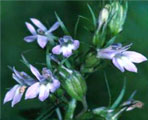



This small annual plant grows to about one foot. It has oval leaves but can have a variable appear?ance. Its flowers are arranged in a spike; the white petals often have a red tinge, but may be purple-veined or have a yellow spot on the lower petal. It blooms from July to September. The flowers have the appearance of blood?shot eyes. It is believed to have originated from European wild plants.
Eyebright was used as early as Theophrastus and Dioscorides, who prescribed infusions for topical application in the treatment of eye infections. This was in large part due to the similarity of the "bloodshot" petals to irritated eyes. The plant has been used in homeopathy to treat conjunctivitis and other ocular inflammations. The plant continues to find use in black herbal medicine.
Further historic data on the use of Euphrasia includes a 14th century cure for "all evils of the eye." An eyebright ale was described in Queen Elizabeth's era. It was a component of British Herbal Tobacco, which was smoked for chronic bronchial conditions and colds. Other early uses include treatments for allergies, cancers, coughs, con?junctivitis, earaches, epilepsy, headaches, hoarseness, inflammation, jaundice, ophthalmia, rhinitis, skin ailments and sore throats.
Eyebright contains the glycoside aucubo?side. In addition, the plant contains a tannin, aucubin, caffeic and ferulic acids, sterols, choline, some basic compounds and a volatile oil.
Other components include vitamin C,3-carotene, glyco?sides, nonacosame, ceryl alcohol, beta-sitosterol, oleic-, and linoleic-, palmitic- and stearic- acids, fumaric acid, isoquercitrin, quercetin and rutin.3 Additionally, the iridoid glycosides catalpol, euphroside and ixoroside, the lignan dehydrodiconiferlyl alcohol 4-[3-D-glucoside, the phenyl?propane glycoside eukovoside, the flavonoid apigenin, gallotannins, traces of tertiary alkaloids, steam-volatile substances and a range of free and combined phenol?carboxylic acids, principally caffeic, p-hydroxy-phe?nylpyruvic and vanillic acids.
Tannins, aucuboside (aucubin),4 seven known glycosides and the new compound, eurostoside5as as seven flavonoids6 have all been isolated Iroo rostkoviana.
None of the chemical compo of eyebright have been associated with a signi! therapeutic effect. There are no, controlled studies in to evaluate its effectiveness in the treatment irritations.
Eyebright is commonly used in European folk me, j for blepharitis and conjunctivitis, as well as for a po for styes and the general management of eye lal They also use it internally for coughs and hoarsenes~ well as a homeopathic remedy for conjunctivitis phenol-carboxylic acids are thought to playa role antibacterial effects of eyebright.
While there are no known risks a! ated with eyebright, its purported activities have noliclinically substantiated and the folkloric use is unacc able on hygenic grounds.
German studies suggest that 10 to 60 drops of eyeon tincture could induce confusion, cephalalgia, violenl~l~ sure in the eyes with tearing, itching, redness andsw ing of the margins of the lids, photophobia, dim visil weakness, sneezing, coryza, nausea, toothache, can! pation, hoarseness, cough, expectoration, dyspni yawning, insomnia, polyuria and diaphoresis. Henl ophthalmic use of this material is strongly discouragel
Eyebright is an herbal remedy that conw ues to find use among herbal enthusiasts. Although adverse effects have been reported with its use, In appears to be little or no evidence in today's scientil literature for its effectiveness.
Copyright © Krishna Herbal Company 2022. All Rights Reserved Powered By: Planet Ayurveda







